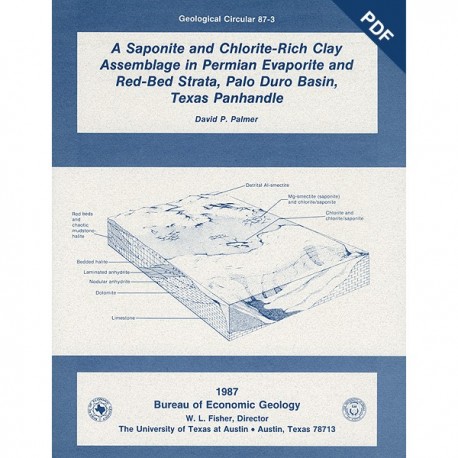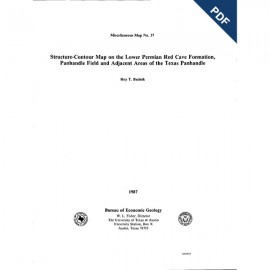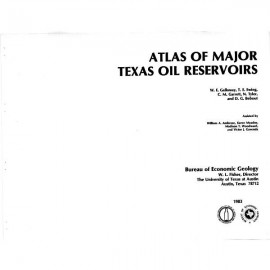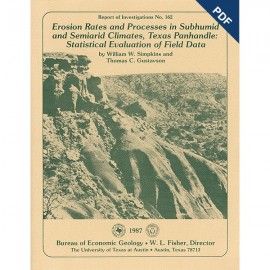Geological Circulars
-
Books & Reports
- Reports of Investigations
- Guidebooks
- Udden Series
- Geological Circulars
- Down To Earth
- Atlases of Major Oil and Gas Reservoirs
- Texas Memorial Museum Publications
- Environmental Geologic Atlas of the Texas Coastal Zone
- Mineral Resource Circulars
- Other Reports
- Seminars and Workshops
- Handbooks
- Submerged Lands of Texas
- Symposia
- Annual Reports
- Open File Reports
-
Maps & Cross Sections
- Thematic Maps
- Miscellaneous Maps, Charts & Sections
- Geologic Atlas of Texas
- STATEMAP Project Maps
- Geologic Quadrangle Maps
- Cross Sections
- Highway Geology Map
- Energy and Mineral Resource Maps
- Shoreline Change and Other Posters
- Wilcox Group, East Texas, Geological / Hydrological Folios
- Bouguer Gravity Atlas of Texas
- River Basin Regional Studies
- Featured Maps
- Posters
- Teachers & the Public
-
Geological Society Publications
- Gulf Coast Association of Geological Societies
- Alabama Geological Society
- Austin Geological Society
- Corpus Christi Geological Society
- Houston Geological Society
- Lafayette Geological Society
- Mississippi Geological Society
- New Orleans Geological Society
- South Texas Geological Society
- GCS SEPM Publications
- Historic BEG & UT Series
A Saponite ... Clay Assemblage in Permian ...Strata, Palo Duro Basin, Texas Panhandle. Digital Download
GC8703D
For a print version: GC8703.
GC8703D. A Saponite and Chlorite-Rich Clay Assemblage in Permian Evaporite and Red-Bed Strata, Palo Duro Basin, Texas Panhandle, by D. P. Palmer. 21 p., 13 figs., 5 tables, 1 appendix, 1987. doi.org/gc8703D.Downloadable PDF
To purchase this publication in book format, please order GC8703.
ABSTRACT
Permian strata in the Palo Duro Basin consist of multicyclic sequences of carbonate, nodular and laminated anhydrite, bedded halite, chaotic mudstone-halite, and terrigenous clastic sediments. These evaporite lithofacies record deposition in a shallow-water marine evaporate shelf depositional system. Clastic sediment derived from surrounding highlands contributed aluminous detritus to the basin, including aluminum-rich smectite, illite, and mixed-layer illite/smectite clays.
The clay assemblage, identified by X-ray diffraction of clay-size samples, included saponite, mixed-layer chlorite/smectite, chlorite/vermiculite, chlorite/swelling chlorite, vermiculite/swelling chlorite, chlorite, and illite. The clay assemblage is distinct in that it consists of a series of magnesium-rich clays. Saponite is a magnesium smectite, vermiculite has hydrated interlayer magnesium as well as structural magnesium, and chlorite has a brucite interlayer and structural magnesium. Chemical analyses of selected samples confirm the magnesium-rich clay chemistry and show that the clays must contain structural as well as interlayer magnesium. These clays are typical of other ancient marine evaporite deposits.
Because the detrital clays were aluminum-rich, they must have undergone diagenetic alteration in association with a source of abundant magnesium. Marine evaporite brine is the magnesium source. The physicochemical characteristics of ancient marine evaporites can be inferred by analogy with modern marine evaporite environments. Modern marine evaporate brines characteristically exhibit high magnesium ion activity, high salinity, and slightly acidic to neutral pH. Sediments deposited in the evaporite environment would have a residence time in brine pan or ground-water brine that varied depending on their location in the evaporate depositional system.
Clay-brine reactions should produce a diagenetic clay alteration sequence from aluminous detrital clays to magnesium clays. First, magnesium replaces other cations on exchange sites and in interlayer spaces. Second, continued residence time and high magnesium ion activity in the brine force substitution of magnesium for aluminum in the octahedral layer. Third, partial and random brucite interlayers begin to precipitate. Brucite subsequently precipitates in alternating interlayer spaces, forming mixed-layer clay species. Finally, complete brucite interlayers are formed in all interlayer spaces, yielding a chlorite end product. Rates and amounts of clay alteration are probably controlled by magnesium ion activity, brine salinity, brine pH, and clay residence time in the marine evaporite environment.
Keywords: Brucite, chlorite, clays, evaporite, hypersaline, magnesium-rich, mixed-layer, Palo Duro Basin, saponite, Texas
Citation
Palmer, D. P., 1987, A Saponite and Chlorite-Rich Clay Assemblage in Permian Evaporite and Red-Bed Strata, Palo Duro Basin, Texas Panhandle: The University of Texas at Austin, Bureau of Economic Geology, Geological Circular 87-3, 21 p. doi.org/10.23867/gc8703D.






